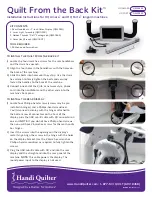
ISO-HPO-2
World Precision Instruments
5
3. Add 231
m
L of 2-4% H
2
O
2
(Sigma-Aldrich 323381) to the flask.
4. Then, use the removed 1mL of solution from step 2 to dilute the solution in the
flask to exactly 250mL again.
5. Store this standard solution in an amber bottle, if available, or alternatively, wrap
aluminum foil around the bottle to limit light intrusion. This solution should be
refrigerated.
Making of 0.1M PBS Buffer Solution
Dissolve 1 Sigma tablet (Sigma-Aldrich P4417-100TAB) into 200mL deionized water
(DIW). This solution yields 0.01M phosphate buffer, 0.0027M potassium chloride and
0.137M sodium chloride, pH 7.4, at 25 °C.
Calibration Procedure
1. Polarize the sensor. See “Polarizing the Sensor” on page 3.
2. Record the current value after a 10–15 minute settling period. If the current is
offscale or unstable after a half hour in solution, it is likely that the membrane has
been damaged and the sleeve needs to be changed. (See “Replacing the Mem-
brane Sleeve” on page 7.)
NOTE
: The calibration should be carried out at the temperature at which the
samples of H
2
O
2
are to be measured. This can be accomplished by placing the
vial and stand in a water bath at the appropriate temperature, and allowing the
temperature of the solution in the bottle to equilibrate with the water bath.
Creating a Calibration Curve
To create a calibration curve, measure the current (pA) generated by the addition of
increasing amounts of H
2
O
2
to the calibration solution.
1. Wait for current output to stabilize.
2. Consecutively add known volumes of the H
2
O
2
standard solution to the PBS buf-
fer solution. For example, add 0, 5, 10, 20, 40 and 80
m
L H
2
O
2
standard solution
(1.0mM) into the 10mL PBS buffer solution. The additions can be added once
every 20-30 seconds. The resulting output should look similar to the example in
Fig. 3.
Fig. 3—Calibration Curve
Содержание ISO-HPO-2
Страница 2: ......
Страница 4: ...ii World Precision Instruments...


































